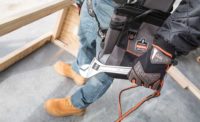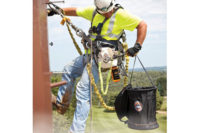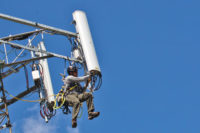It’s hard to fathom that in this day and age of real-time data, education and technology, worker fatalities in the U.S. have actually increased (up 7 percent in 2016 according to the Bureau of Labor Statistics).
Clearly, when it comes to jobsite safety, there’s still work to do. Take the hazard of dropped objects. It’s an often forgotten about aspect of at-heights safety, but the numbers prove they shouldn’t be. While awareness has grown over the last handful of years, the risk only really truly appears to move from the periphery when a tragic story — like the 58-year-old man from New Jersey who died after being struck with a tape measure in 2014 — goes viral. Yet each year, drops kill hundreds and injure tens of thousands more, not to mention the close calls that don’t get reported. Think about those undiagnosed concussions from something hitting a worker in the hard hat. Or all the near misses that could have been tragic with one step forward or back.
Dropped objects are not an “if” proposition. And gravity does not discriminate. Young, old, experienced or not. It doesn’t matter. Drops will happen.
Limited protection
A variety of PPE has been invented to protect people against flying and falling objects. The most commonly deployed have been around for the better part of a century. Safety glasses of today were invented in 1914, hard hats in 1919 and steel toe boots in 1930. All designed to protect workers against falling and flying objects.
The problem is these solutions can only protect you under certain circumstances. A hard hat may help against material falling from a few stories, but how about a tool falling from 50+ stories or one that strikes a worker in the back?
PPE is always the last line of defense against dropped objects, so why not prevent the objects from ever falling in the first place? Nearly a hundred years since its invention, are we still OK with just popping a hard hat on and calling it good?
Setting a higher standard with ISEA 121
The movement to prevent — not just protect from — dropped objects is here. The proactive solutions and ways of thinking innovated by the pioneers in the budding category of Objects at Heights have started to gain traction. Conversations are being held. Attitudes are shifting. Concepts are slowly leaking into the mainstream. And a crucial realization coming to light: a reactive strategy is really no strategy at all.
Leading safety equipment manufacturers have been building on that momentum, finding ways to demystify the concept of tool tethering with training, education and innovative solutions like tool tethering kits that provide all-in-one convenience for commonly used tools and easy one-step tool attachment points that do away with the need to use adhesives, shrinks or other trapping methods to create retrofit attachment points on tools.
Going even further, those safety equipment manufacturers have teamed with the International Safety Equipment Association (ISEA) to develop a standard for equipment solutions that prevent dropped objects.
When officially released later in the year, ISEA 121 will establish minimum design, performance/testing and labeling requirements for dropped object prevention solutions including tool and anchor attachments, tool tethers and containers that transport tools and equipment to and from at-heights work zones.
The new standard will address:
- Anchor Attachments – Retrofit attachment points installed onto fixed anchor locations like structure or a worker themselves to anchor tool tethers.
- Tool Attachments – Retrofit attachment points installed onto tools and equipment, allowing them to be tethered.
- Tool Tethers – Lanyards that connect tools to an anchor point.
- Containers – Bags, buckets and pouches that are used to transport tools and equipment to and from at-heights work zones.
The new dropped objects measure will not cover things like passive preventative solutions (netting, toe boards, etc.) or best practices in the field, like telling workers where they should connect a tool lanyard on their harnesses, for example.
Though ISEA 121 will be a voluntary standard and not directly enforceable, it will establish a formalized industry best practice that agencies like OSHA can look to when enforcing things like the general duty clause. Only time will tell how this standard and enforcement will intertwine, but the end result is most certainly a safer work zone. And, maybe just as important, it’s a big step in progressing the awareness and proactive attitudes needed to solve for this safety hazard in a truly meaningful way.



